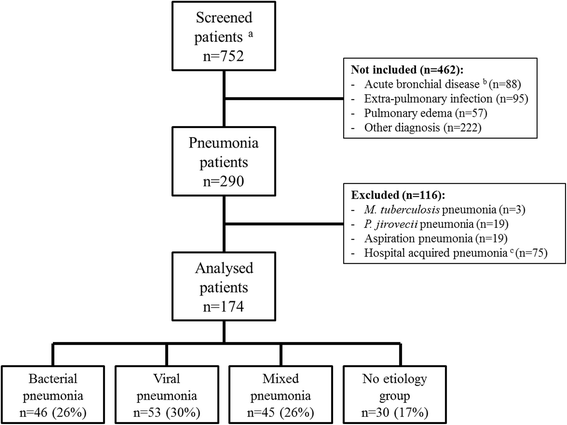Viral-bacterial coinfection affects the presentation and alters the prognosis of severe community-acquired pneumonia
- PMID: 27852281
- PMCID: PMC5112669
- DOI: 10.1186/s13054-016-1517-9
Viral-bacterial coinfection affects the presentation and alters the prognosis of severe community-acquired pneumonia
Abstract
Background: Multiplex polymerase chain reaction (mPCR) enables recovery of viruses from airways of patients with community-acquired pneumonia (CAP), although their clinical impact remains uncertain.
Methods: Among consecutive adult patients who had undergone a mPCR within 72 hours following their admission to one intensive care unit (ICU), we retrospectively included those with a final diagnosis of CAP. Four etiology groups were clustered: bacterial, viral, mixed (viral-bacterial) and no etiology. A composite criterion of complicated course (hospital death or mechanical ventilation > 7 days) was used. A subgroup analysis compared patients with bacterial and viral-bacterial CAP matched on the bacterial pathogens.
Results: Among 174 patients (132 men [76 %], age 63 [53-75] years, SAPSII 38 [27;55], median PSI score 106 [78;130]), bacterial, viral, mixed and no etiology groups gathered 46 (26 %), 53 (31 %), 45 (26 %) and 30 (17 %) patients, respectively. Virus-infected patients displayed a high creatine kinase serum level, a low platelet count, and a trend toward more frequent alveolar-interstitial infiltrates. A complicated course was more frequent in the mixed group (31/45, 69 %), as compared to bacterial (18/46, 39 %), viral (15/53, 28 %) and no etiology (12/30, 40 %) groups (p < 0.01). In multivariate analysis, the mixed (viral-bacterial) infection was independently associated with complicated course (reference: bacterial pneumonia; OR, 3.58; CI 95 %, 1.16-11; p = 0.03). The subgroup analysis of bacteria-matched patients confirmed these findings.
Conclusions: Viral-bacterial coinfection during severe CAP in adults is associated with an impaired presentation and a complicated course.
Keywords: Intensive care; Pneumonia; Respiratory viruses; Viral pneumonia.
Figures

Comment in
-
Viral and bacterial co-infection in pneumonia: do we know enough to improve clinical care?Crit Care. 2017 Jan 26;21(1):19. doi: 10.1186/s13054-016-1592-y. Crit Care. 2017. PMID: 28122641 Free PMC article. No abstract available.
Similar articles
-
Impact of microbial Aetiology on mortality in severe community-acquired pneumonia.BMC Infect Dis. 2018 Sep 4;18(1):451. doi: 10.1186/s12879-018-3366-4. BMC Infect Dis. 2018. PMID: 30180811 Free PMC article.
-
Impact of respiratory viruses in hospital-acquired pneumonia in the intensive care unit: A single-center retrospective study.J Clin Virol. 2017 Jun;91:52-57. doi: 10.1016/j.jcv.2017.04.001. Epub 2017 Apr 22. J Clin Virol. 2017. PMID: 28494435 Free PMC article.
-
One year after ICU admission for severe community-acquired pneumonia of bacterial, viral or unidentified etiology. What are the outcomes?PLoS One. 2020 Dec 14;15(12):e0243762. doi: 10.1371/journal.pone.0243762. eCollection 2020. PLoS One. 2020. PMID: 33315946 Free PMC article.
-
[Update pneumonia 2012].Dtsch Med Wochenschr. 2012 Nov;137(44):2265-80; quiz 2281-4. doi: 10.1055/s-0032-1305297. Epub 2012 Oct 23. Dtsch Med Wochenschr. 2012. PMID: 23093399 Review. German.
-
Viral respiratory infections: a cause of community-acquired pneumonia or a predisposing factor?Curr Opin Pulm Med. 2020 May;26(3):208-214. doi: 10.1097/MCP.0000000000000666. Curr Opin Pulm Med. 2020. PMID: 32068577 Review.
Cited by
-
IFI44 is an immune evasion biomarker for SARS-CoV-2 and Staphylococcus aureus infection in patients with RA.Front Immunol. 2022 Sep 15;13:1013322. doi: 10.3389/fimmu.2022.1013322. eCollection 2022. Front Immunol. 2022. PMID: 36189314 Free PMC article.
-
Immunological Features of Respiratory Syncytial Virus-Caused Pneumonia-Implications for Vaccine Design.Int J Mol Sci. 2017 Mar 4;18(3):556. doi: 10.3390/ijms18030556. Int J Mol Sci. 2017. PMID: 28273842 Free PMC article. Review.
-
Clinical presentation, microbiological aetiology and disease course in patients with flu-like illness: a post hoc analysis of randomised controlled trial data.Br J Gen Pract. 2022 Feb 24;72(716):e217-e224. doi: 10.3399/BJGP.2021.0344. Print 2022 Mar. Br J Gen Pract. 2022. PMID: 34990385 Free PMC article. Clinical Trial.
-
Infection with different human influenza A subtypes affects the period of susceptibility to secondary bacterial infections in ferrets.FEMS Microbes. 2022 Apr 29;3:xtac011. doi: 10.1093/femsmc/xtac011. eCollection 2022. FEMS Microbes. 2022. PMID: 37332495 Free PMC article.
-
Prevalence of atypical pathogens in patients with severe pneumonia: a systematic review and meta-analysis.BMJ Open. 2023 Apr 11;13(4):e066721. doi: 10.1136/bmjopen-2022-066721. BMJ Open. 2023. PMID: 37041056 Free PMC article.
References
-
- Wiemken T, Peyrani P, Bryant K, Kelley RR, Summersgill J, Arnold F, et al. Incidence of respiratory viruses in patients with community-acquired pneumonia admitted to the intensive care unit: results from the Severe Influenza Pneumonia Surveillance (SIPS) project. Eur J Clin Microbiol Infect Dis. 2013;32(5):705–710. doi: 10.1007/s10096-012-1802-8. - DOI - PubMed
Publication types
MeSH terms
LinkOut - more resources
Full Text Sources
Other Literature Sources
Miscellaneous

